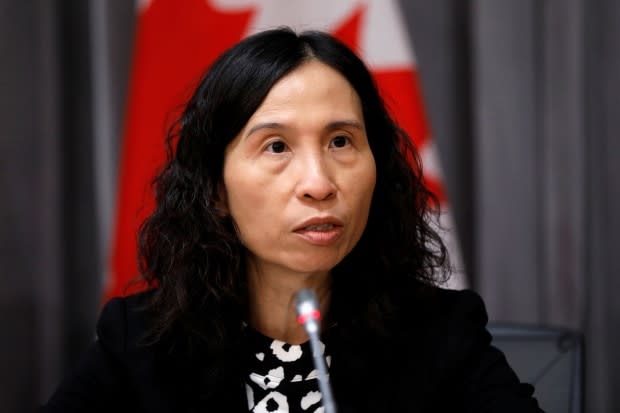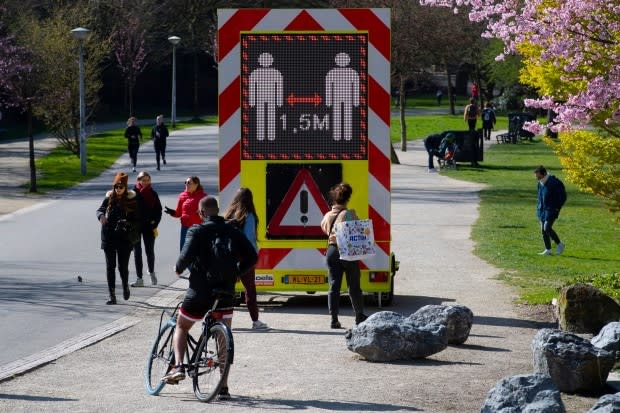The world could face a 2nd wave of COVID-19: Here's what Canada needs to do now to prepare
Canada and other countries must prepare for a second wave of the COVID-19 outbreak to emerge once social distancing measures are eased, and they should only lift those measures gradually, infectious disease experts say.
A second wave of an outbreak is an increase in infections that occurs after a sustained period of time when there are no — or very few — new cases of that illness, said Dr. Isaac Bogoch, a Toronto General Hospital Research Institute clinical investigator, who specializes in infectious diseases.
"Essentially, what we have now is physical distancing measures in place as one of a multi-pronged approach to curb the Canadian epidemic," said Bogoch. "Now, of course, we cannot sustain these physical distancing measures for an infinite period of time.… They're tough on the individual level, they're tough for communities, they're tough for businesses, tough for kids."
The good news is that Canada has the opportunity to learn from countries where the epidemic started months earlier by observing how public health measures in those places work to keep the case load from bubbling up again once people start to emerge from their homes and go about business as usual, he said.
Places in East Asia are facing a second wave of the virus now. For instance, on Friday, Hong Kong recorded its biggest daily jump in cases since the pandemic started, though mostly connected to infected travellers, who are returning from abroad after being prevented from going home before.

Dr. Theresa Tam, Canada's chief public health officer, warned last week that "this virus is going to be with us for some time. It will not be eradicated from the world in months."
"We will need to be prepared for another wave, potentially."
Like Hong Kong, Singapore and Taiwan, Canada will also experience its own second wave after seeing initial success containing the virus through the social distancing measures currently in place, Bogoch believes.
When we start to lift those measures in the months down the line, are we going to start to see a rebound of the virus? The answer is most certainly yes. - Dr. Isaac Bogoch, Toronto General Hospital Research Institute
"When we start to lift those measures in the months down the line, are we going to start to see a rebound of the virus? The answer is most certainly yes. We probably will see, to some extent, a greater number of cases as people mingle again as life slowly returns to normal."
Lifting social distancing measures slowly
Several modelling studies have been conducted to explore how effective social distancing is at dampening disease spread, said Bogoch, and almost all show that when the reins are eventually loosened, cases will tick up again.
But he said there are steps we can take to minimize the extent of a second wave.
"The hope is that we can slowly lift these measures, rather than have them completely lifted, and we can control the rebound of the virus such that it does not cause a situation where we overwhelm our health-care system and negate everything that we've done for the past few months."
The key will be to change social distancing policies "very slowly and carefully," he said.
Eleanor Fish, a professor of immunology at the University of Toronto whose research group conducted treatment studies during the 2003 outbreak of SARS in Toronto, said a true second wave of an outbreak involves new community transmissions, not just sick returning travellers who are swiftly moved into quarantine.

She said countries like China, where new cases are also travel-related, could face a second round of the outbreak but are "nowhere near" that territory yet.
'We haven't locked down our borders'
Fish also said she believes a second wave is "unlikely to happen here."
"We haven't locked down our borders to Canadians. So any of those who might want to return, are returning. We're asking them to self-isolate for 14 days." That means Canada is less likely than other countries who shut their borders to citizens to have cases shoot up again upon their return.
Fish said she's optimistic that the government is listening to the scientific community and learning from places, like Italy, by preparing for a surge of severe cases by doing things like securing more ventilators. She also said she was buoyed by progress of research groups testing various forms of treatment.
"The public needs to be reassured that there's a lot coming up that's going to be very positive."
Jason Kindrachuk, an assistant professor at the University of Manitoba's department of medical microbiology, said that during the 1918 Spanish flu pandemic, there was both a second wave and a small third wave of the outbreak.
Improving supply of equipment, testing materials
But he said Canada can prepare now for a second wave of COVID-19 illnesses in a number of different ways.
It can improve the supply of personal protective equipment for front-line health-care workers, as well as the materials needed for testing, both of which have already been a challenge in the first phase of the epidemic, said Kindrachuk, who holds a Canada Research Chair in emerging viruses.

And although little is known yet about the seasonality of the virus and how much immunity people will have after recovering from the illness, Canada can look to the nations that are months ahead of it in the progression of the pandemic.
We can learn from what those countries do in terms of when they start reducing the requirements for social distancing to help guide our own procedures and time frame for doing that so we don't see spikes in increased transmission. - Jason Kindrachuk, University of Manitoba's department of medical microbiology
"We can learn from what those countries do in terms of when they start reducing the requirements for social distancing to help guide our own procedures and time frame for doing that so we don't see spikes in increased transmission."
The true long-term strategy, said Bogoch, is the creation of an effective vaccination, "which we know is more than a year away."
"But for now, we just have to put up with the physical distancing measures."


